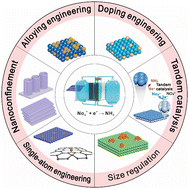Structural engineering of catalysts for ammonia electrosynthesis from nitrate: recent advances and challenges
Abstract
Ammonia (NH3) is an indispensable industrial chemical used in fertilizer production and energy carriers. However, its production through the Haber–Bosch process requires high temperature and high pressure, consuming significant energy and releasing large amounts of CO2, rendering it unsustainable. As a result, sustainable approaches for ammonia synthesis powered by renewable electricity have gained significant attention, such as the electrocatalytic N2 reduction reaction (N2RR) and nitrate reduction reaction (NitRR). This review summarizes recent advancements in the design strategies of electrocatalysts for the NitRR, highlighting synthetic methods such as doping, alloying, single-atom engineering, nanoconfinement, size-regulation, and tandem catalysis. These strategies aim to tune the adsorption of reactants and intermediates or enhance proton–electron transfer. Future studies could explore new electrocatalysts for efficient NitRR based on the strategies summarized in this review to improve nitrate pollution removal efficiency and ammonia production rates. Furthermore, the challenging questions raised at the end of the paper, such as optimizing the reaction kinetics of the NitRR and improving catalyst selectivity and stability, can provide new directions and insights for future catalyst design.

- This article is part of the themed collections: EES Catalysis Recent Review Articles, Catalysis showcase, Most Highly Cited in RSC Energy 2024 and EES Catalysis Hot Papers


 Please wait while we load your content...
Please wait while we load your content...